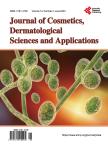Performance of Cosmetic Ingredients Evaluated by Their Membrane Protection Efficiency
Performance of Cosmetic Ingredients Evaluated by Their Membrane Protection Efficiency作者机构:Departamento de Bioquímica Instituto de Química Universidade de Sã o Paulo Sã o Paulo Brazil
出 版 物:《Journal of Cosmetics, Dermatological Sciences and Applications》 (化妆品、皮肤病及应用期刊(英文))
年 卷 期:2021年第11卷第3期
页 面:169-185页
学科分类:1008[医学-中药学(可授医学、理学学位)] 1006[医学-中西医结合] 100602[医学-中西医结合临床] 10[医学]
主 题:Photoprotection Antioxidants Sugars Polyphenols Flavonoids Photochemistry
摘 要:Plant extracts (PEs) are frequently used as ingredients in skin and hair care products to improve protection against the excess of sun exposure. PEs are usually selected based on their antioxidant capacity for reducing the damage in lipids and proteins, which are key molecules in the maintenance of skin homeostasis and hair integrity. Interestingly, biomolecules that do not have any antioxidant capacity can have a protective effect by physically adsorbing and inhibiting leakage of membranes. Our aims are: 1) to develop an experimental protocol that quantifies the level of membrane damage/protection;2) to recommend an approach to compare the membrane protection efficiency of different PEs;3) to briefly describe the mechanisms of membrane protection. Evaluation of membrane damage/protection is based on a phospholipid liposome system that signals the membrane rupture caused by photo-induced lipid oxidation. Carboxyfluorescein (CF) emission is monitored as a function of time (120 min) in a controlled experimental setup, in which a certain level of membrane damage is induced by Dimethyl-Methylene Blue (DMMB) photosensitized oxidation during red-light irradiation. Percentage levels of membrane damage/protection are calculated by comparing the CF fluorescence level of DMMB-liposomes in the presence of varying concentrations of membrane-protective ingredients with that of surfactant-dissolved DMMB-liposomes. Membrane protectants reduce the level of CF fluorescence during irradiation of DMMB-liposomes. Gallic acid (GA) and trehalose (Tre) were used as standard compounds to compute the levels of protection by the antioxidant and physical adsorption mechanisms, respectively. The percentage of membrane protection was shown to be linearly proportional to the concentration of the standard protectants. The performance of PEs was measured and compared in terms of GA or Tre membrane protection equivalents. All extracted also had their antioxidant capacities evaluate by the anti-radi



